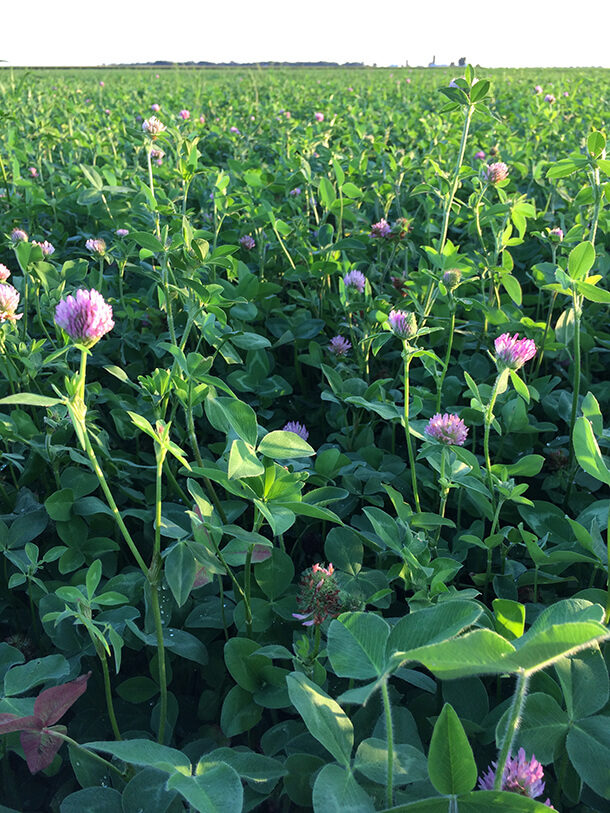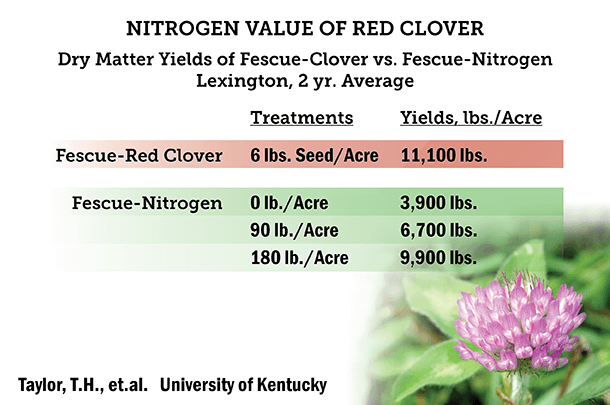There are two preferred times of year to consider legumes for introduction: late summer (no-till), and late winter (frost seeding). Using a no-till drill in late summer is an excellent way to seed legumes into pasture. Seed-to-soil contact is maximized, shortening the time needed for suitable germination and establishment. Red clover, white clover, and alfalfa are great choices this time of the year.

Frost seeding or over-seeding a legume into pasture should be done before frost leaves the soil structure. The basic principle is that alternating freeze/thaw action of soil in late winter/early spring, along with spring rains, incorporates broadcasted legume seed. In the Midwest, mid-February through late March/early April would be the normal time for frost seeding, whether snow is present or not.
Frost seeding offers several important advantages. Sod disturbance is kept at a minimum, ideal for erodible areas. Animals can access areas for grazing quicker than with conventionally tilled seedbeds. Keep in mind, labor and equipment costs are minimal with frost seeding. Over-seeding involves some risks, not the least of which is precipitation. While we cannot control the weather, there are key management practices that can increase the likelihood of getting a good clover stand by over-seeding in the upcoming months:
• Soil tests taken the fall before should indicate whether fertilizer is needed to support the planned legumes (especially phosphorus needed for germination and potassium to support plant health, along with pH).
• Ideally, the pasture would be grazed or clipped closely the previous fall to reduce the amount of thatch present. Intentional “grazing abuse” provides openings in the grass for clover emergence and set back the grass the following spring just enough to allow the clover to further establish.
• Following seeding, the area can be grazed as the tramping action of hooves will help incorporate the seed, as well as reduce the competition between grass and the new legume seedlings. However, care must be taken not to overgraze until the legumes have become established. Cattle should be removed from the pasture before clover seedlings emerge, but can be brought back to graze down (often flash grazed) grasses when they are 8 to 12 inches high. Sure, some clover could be lost during this time, but the few seedlings sacrificed are far less than the number of seedlings that would be lost to competition for light and moisture if the established grasses are not grazed at all.

Most adapted forage legume species are suitable for frost seeding. Red clover is most commonly used due to excellent seedling vigor, but white clover, birdsfoot trefoil, and alfalfa also work. Alfalfa should not be used if the existing pasture contains alfalfa, due to alfalfa autotoxicity. Frequency of seeding depends on how well the level of legumes is maintained in the stand, but a rule of thumb is to over-seed one third of your pasture acres each year.
Note, 3-year clovers (available in most every market) differ from traditional medium red clovers that usually last 1 to 2 years under normal management. These improved clovers offer stronger resistance to crown rot and other disease pressures that ultimately result in the demise of a traditional red clover stand. That extra year of production more than pays for the slightly higher cost for seed. Nonetheless, whether seeding 3-year red clovers or traditional varieties, consider these reminders to ensure persistence is maximized:
• Red clover stands allowed to reach full bloom during their establishment year frequently suffer lower yields and poorer stands in year two. If fertility is not limiting and hay is needed, harvest multiple times, but do it prior to mid-bloom (even early bloom would be a good decision here).
• On existing stands, the first cutting of the year should be made around early bloom, however following cuttings can be made earlier (think bud or early-bloom stage). Timing is critical in spring as clover plants, just like alfalfa, need crucial energy reserves to persist.
• When conditions turn hot and dry, consider leaving the equipment in the shed. A light grazing could be attempted, but only if hay is badly needed. Once cooler temperatures arrive, then regular harvest schedules can return.
To summarize, adding a legume to your existing pasture is an economical way to add value to the pasture. Improved pastures result in high forage quality, higher yields, and improved animal health. For additional forage management information and product options available from Forage First® and La Crosse Seed, visit www.lacrosseseed.com. ![]()
Scott Wohltman is with Forage First and La Crosse Seed.
PHOTO 3: From research out of the University of Kentucky, the value of only six pounds of red clover seeded into tall fescue pasture out-yielded fescue that had as much as 180 pounds of actual nitrogen added. Granted, nitrogen costs currently are lower than in previous years. However, six pounds of red clover seed is substantially more economical than even the median application rate in this study.








